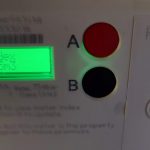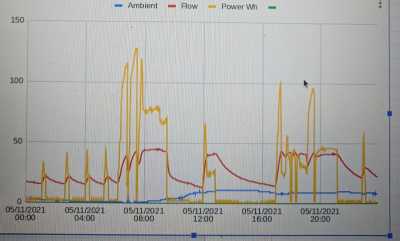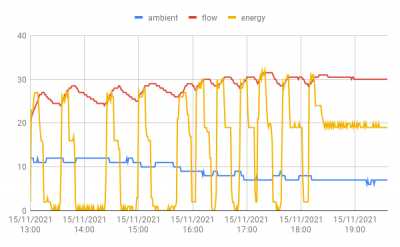New to Heat Pumps
Posted by: @kev-mIs there a sensitivity setting on your room thermostat will stop it reacting to small variations in room temperature
Morning,
Mirnes, good progress. You now have a slightly more clever thermostat, which will switch the ASHP on and off less often, running at a constant flow temp. The next step (I think) is to do the same at a weather compensated flow temp and see how that goes.
What I, @batalto and others are trying, is to bypass the thermostats by turning them up high (so that they are always calling for heat) and let the weather compensation control the temperature of the house by varying the flow temp. Currently, doing this, my house has stayed at 21-22C when it's been between 6C and 12C outside. So far so good but I need some colder weather to test it more.
Posted by: @kev-mis to bypass the thermostats by turning them up high (so that they are always calling for heat)
I understand, but wouldn't that mean that the ASHP is always working, because weather compensation just lowers or raises the waterflow temperature, but doesn't actually turn the unit OFF?
Hi Mirnes,
Your ASHP will still start and stop when on weather compensation, but should operate more efficiently. There are two main factors which affect the efficiency of your ASHP, one is the outside air temperature, which as it gets colder means that your ASHP has to work harder to extract heat energy from the surrounding air, and the other factor is the water flow temperature. The higher the required water flow temperature, the longer and harder your ASHP has to work to achieve the required water temperature. When your ASHP is operating on weather compensation, the required water temperature is set dependent upon the outside air temperature, but in the same way as your thermostat stops your ASHP when the room is up to temperature, the weather compensation will stop your ASHP when the water is up to temperature. During milder weather conditions the required water flow temperature will be lowered, so your ASHP will not have to work so hard and will be more efficient.
Because you have to select a weather compensation curve from those available, it is unlikely that it will perfectly match the requirement for your home, so you will still need to operate your system with the thermostat controlling the indoor temperature. But by setting the water flow temperature automatically using weather compensation, should improve the overall efficiency of your system.
Do you have any reading of Coefficient of Performance (COP) on your controller?
Just like a car engine, your ASHP is designed to operate for many years, and prefers to operate for longer periods, rather than be starting and stopping.
To keep the room at a more constant temperature you could set the hysteresis on your thermostat to +/- 0.25C, which again could slightly improve the efficiency.
Mirnes,
Here are a couple of graphs that show my ASHP working your way and then my current way. The first is 24 hrs, the second is 6-7 hours. Take care looking at the y-axes; the scales are different although the units are the same.
Here, the ASHP is responding to a thermostat with the flow temp controlled by weather compensation. It's set to 21C morning and evening and 18C at other times. From midnight, it's coming on periodically because the ambient temp is 5C or below - that's automatic. I assume it's to stop watrer pipes freezing. In the morning and evening the ASHP responds to the thermostat and comes on. In between the house stays at 18C or above so no heat required. The peak midday is hot water. In the evening you can also see the thermostat stop calling for heat, making the ASHP turn off and then calling and starting up again. The energy peaks are high, although the ASHP is off a lot of the time.
Below is with the thermostats turned up. As @derek-m says, the ASHP isn't heating all the time if it doesn't have to. Most of the time it runs for a bit then stops. These cycles are every 30-40 mins. When it gets a bit colder (look at the blue line), it can run at its minimum level constantly.
As Derek also says, these units are built to last for years. They are the same technology as your freezer and fridge and these don't break very often. My freezer compressor turns on and off all the time.
Which way is better? Well currently my house is warm all the time, which is nice. The ASHP is running more efficiently (better COP), which is good. But, it's running for more time. Is it cheaper? I suspect it is, but I don't know yet.
Hope this helps.
-
British Gas Heat Pump Installation Complaint
2 months ago
-
Heating Turned Off but Radiators Still Warm
3 months ago
-
Samsung Heat pump with Yonos Pico circulating pump running all the time
3 months ago
-
Samsung 5kW R32 Monobloc Gen 6 ASHP
3 months ago
-
Avoid the Heat Pump Villain: Why Low-Loss Headers and Buffers Can Sabotage Your Heat Pump's Efficiency
4 months ago
- 26 Forums
- 2,367 Topics
- 53.7 K Posts
- 219 Online
- 6,042 Members
Join Us!
Worth Watching
Latest Posts
-

RE: Water Hammer After Heat Pump Install
As far as I know this occurs when a valve/ tap closes v...
By Jancold , 48 minutes ago
-
Mitsu PUHZ-SW120YHA + EHSC-VM20Uk - Performance
I would appreciate any comments on the performance of m...
By DavidAlgarve , 2 hours ago
-
RE: Who's your electricity provider and what's your tariff?
@majordennisbloodnok This may be a better thread to ...
By Batpred , 16 hours ago
-
RE: Help needed with Grant Aerona 3 issues
Noted. Its a pity you didnt capture the flow rate and ...
By JamesPa , 22 hours ago
-

RE: Best Heat Pump Brand in the UK
Last Call to Vote & Win! Haven't voted for your Hea...
By Mars , 22 hours ago
-

RE: Solis S6-EH1P8K-L-PLUS – Why I Chose It and What I’ve Learned So Far
Interesting question. To be frank, since I have no inte...
By Majordennisbloodnok , 1 day ago
-
RE: Changing from 4-port buffer to volumizer
@andy1618 see the very sage advice from @editor above. ...
By JamesPa , 2 days ago
-
RE: New Fogstar 15.5kWh upright solution
The video shows the JK balancer, but the connection of ...
By Batpred , 2 days ago
-
RE: Ecodan unable to hit legionella target temp - what's the consensus?
@9jwr9 Hi, yes this is the issue with every (stand alon...
By ASHP-BOBBA , 2 days ago
-
RE: Help me keep the faith with my air source heat pump installation
@adamk FWIW I managed unintentionally to 'coax' mine in...
By JamesPa , 2 days ago
-
RE: Octopus Cosy Heat Pump Owners & Discussion Thread
You are in essence right. Adia only works with selecte...
By JamesPa , 2 days ago
-

No, you haven’t missed out, @batpred. This thread’ll st...
By Majordennisbloodnok , 2 days ago
-

RE: Tesla Powerwall – More of a ‘Luxury’ Than an ROI Winner!
Also, though they weren’t prepared to match the price t...
By Toodles , 2 days ago
-
RE: How long will your energy contract last?
My INTELLI-FIX-12M-25-08-29 has less than 12 months to ...
By Batpred , 2 days ago
-

RE: GivEnergy 2025 forthcoming batteries and inverters
Then, perhaps @toodles , you should've made a submissio...
By Transparent , 2 days ago
-
RE: Balancing financial efficiency and comfort using the Octopus Cosy tariff
I am wondering if anyone with an EV could find the 7p/k...
By Batpred , 2 days ago
-
Possibly, but it would also reduce DeltaT across the em...
By JamesPa , 2 days ago
-

RE: ASHP sizing - value of Heat Transfer Coefficient
@cathoderay It was reminiscent of the BBC Open Universi...
By Toodles , 2 days ago
-






